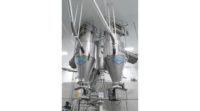Ingredient handling equipment runs the gamut from storage and transport, to metering, dispensing, and automation addition. Snack food and bakery customers of this equipment are particularly interested in features and benefits like automation, food safety, flexibility, adaptability, quick changeover, ease of maintenance and cleaning, explosion protection, lot tracking, and inventory control.
Views from the field
Food safety and how best to interpret the requirements around it are top of mind for customers of Bühler Inc., Plymouth, MN, according to John Hunter, sales account manager for bakery and ingredient handling. “Different customers have different perspectives on that,” he says. “We’ve had to design equipment accordingly.”
The explosion mitigation standards for ingredient handling equipment have been impacted somewhat by more stringent regulations in Canada, although U.S. customers are asking about it, as well, Hunter says. “Explosion mitigation is not cheap,” he says. “That is having an effect on what we provide. That’s a big impact for everybody. Sometimes, our design has to be adjusted.”
AZO Food, Memphis, TN, and its systems integration partner, Bachelor Controls, have heard from customers who want flexibility and adaptability, says Kevin Pecha, sales manager for AZO. “They want to use the equipment for a while and then be able to switch it to something else,” he says. “They want to make sure that the system, when it’s designed, can be upgraded to add new components in the future.”
Rusty Bailey, branch manager, Bachelor Controls, says customers are trying to minimize idle time. “They want to make changes to the system quicker,” he says. “They want to be able to do product changeover. People want to be more flexible and agile.”
Customers of Doran Scales, St. Charles, IL, are focused heavily on lot tracking, says Mark Kuchuris, vice president of business development. “They’re looking for the ability to take the paperwork off the floor and validate instantly what’s in their product,” he says. This validation would ideally come through an automated system. With the price of ingredients going up, he notes, customers are trying to save money and not pass along those costs to consumers whenever possible.
VAC-U-MAX, Belleville, NJ, likewise has had a focus on efficient raw material use, says David Kennedy, business development manager. “You might call it inventory control, or waste reduction. Some people would call it sustainability,” he says. “They’re not throwing away as much material. They’re getting every ounce of material from what they buy.”
Heat and Control Inc., Hayward, CA, has seen customer desires in areas like improved ease of operation, changeovers, maintenance, and cleaning, as well as the ability to handle a variety of powders efficiently and effectively, with minimal operator interaction required, according to Tim Nanney, technical sales manager, Spray Dynamics.
Equipment updates
Bühler has addressed customer desires for automation by developing the web-based Mercury platform, which enables snack and bakery operators to pull together digital insights about ingredient handling and other data, Hunter says.
“It’s ready to link with the world, and allow us to do data interrogation,” says Hunter. “It also allows us to walk around the bakery with an operator interface, instead of having a fixed position. If somebody were doing maintenance, and the operator wants to look at that particular part of the plant, they can have the control system with them to do that.”
Bühler also has developed an application similar to Google Glass called BühlerVision that allows operators or maintenance people to be online with technical support while they’re looking at a particular piece of equipment, which has proven especially invaluable during the pandemic, notes Hunter. “How do we remotely support our customers? We didn’t have any choice, because COVID wouldn’t allow them to travel.”
The Fred D. Pfening Co., Columbus, has developed a number of solutions for handling both dry and liquid ingredients, says Darren Adams, vice president, engineering. On the dry side, he’s seen makers of tortillas, breads, and buns moving toward vacuum systems like the ones his company offers, which he says provide greater accuracy and less leakage, with increased savings. “In the end, that should result in a more-consistent product,” he says.
The company has been more focused on improving its systems for liquid ingredients because of the greater overall volume, particularly related to water. Pfening’s recently released water-blending system has improved upon the accuracy and temperature control, Adams says. “Within a year from now, we will have a new water metering system altogether,” he says. “It will keep to the same blending system, but it will have fewer moving parts, and a longer life. The main goal is there will be less maintenance.”
AZO Food and Bachelor Controls have developed a piece of weighing equipment that represents an interim step between human operated and fully automated, Pecha says. People still refill the hopper and weigh ingredients out into a container, but the machine picks up measurements electronically rather than someone writing them down on a clipboard, thereby removing the potential for human error.
“It gives the operator everything they need—it prints a tag with all the information,” Pecha adds. When entering ingredients into the final mix, the operator scans the tag and knows everything about all the ingredients that have been pre-weighed. “A lot of people want to have the ability for a computer system to do the work they’re doing by hand, so they don’t make mistakes as often,” he says.
Accuracy of reporting data has become even more crucial since the advent of the FSMA, Pecha says. AZO’s COMPONENTER Step brings weighing accuracy down to the minor and micro component level, with gram accuracy of ingredients like pigments, colorings, flavoring agents, and additives.
“Accuracy and consistency of batch-to-batch go hand-in-hand, which is one of the big drivers of automation,” Bailey says. “From the control side, FSMA is pushing companies to get away from clipboards and manual data entry. Our new suite of batching fits that design criteria quite well, with some of the technology that we now have at our disposal.”
AZO also has developed a robot called RoLog, which replaces the manual weighing process, says Zach Turner, sales engineer. RoLog can be placed in the middle of a circular arrangement of ingredient bins and be told what to batch out and weigh up. It spins 360 degrees and knows exactly where the bins of various ingredients are positioned.
“The entire process is shielded, protected with gates,” Turner says. “There is a robot space and an operator space. The operator receives the completed batch from the robot, puts it on a conveyor belt and spits it out the other side. The idea here is that you can replace a dusty, messy, mistake-prone process that is not exactly everybody’s favorite job. It’s hard to keep that job staffed. You have people weighing that stuff every day and going home with carpal tunnel.”
Doran Scales has done minor hardware upgrades and more significant software upgrades on its FC6300 weighing system, which enables the end user to store formulas in the scale itself, Kuchuris says. It takes a formula with, say, flour, sugar, water, and yeast, and once a bucket is placed on the base fills it with flour until it hits the right weight, and then moves on to the next ingredient until it’s finished with the formula.
“When the formula is complete, you can print the label and then move on to the next formula,” says Kuchuris. “It takes formula sheets off the floor, and it doesn’t allow for the wrong ingredients or the wrong scaling. It tracks incoming ingredients and what’s shipping out the door with lot IDs.” So when the scaler comes up, they don’t need the paperwork, since the information is right there on the screen, he says.
The screen dashboard even provides a red-yellow-green light indicator that means the operator doesn’t need to pay attention to weight. “With the turnover in the industry, and the workforce changing, you don’t have guys who have been doing this for 30 years,” Kuchuris says. “It’s a much easier system if you are training a new scaler or mixer—it’s real simple for anybody to use on day one.”
VAC-U-MAX has been focused on reclaiming toppings that haven’t successfully stuck to the product by the time they get to the end of the conveyor belt. The company’s spreader-feeder device captures that lost material and then recycles it, Kennedy says. “For example, if you have a pastry product like muffins, croissants, or cookies, they often have toppings on them, and all of the toppings don’t always stick,” he says.
The company has customers that put corn starch on the conveyor belt to keep tortillas from sticking. That lost product can be fairly expensive if it’s not reclaimed at the end, Kennedy says. Sesame seeds that don’t stick to their hamburger buns or rolls are another reclamation project. “Whatever doesn’t stick to the buns can be reclaimed and used,” he says.
Heat and Control offers the Uni-Spense line of powder feeders and scarf plate distributors that apply dry powders to base product inside a coating drum or over a belt. Each is customized, the company says, and draws from among a variety of agitation methods, augers, and refill devices to handle products that use salt, sugar, or other seasonings.
“We continue to investigate ways to add value to existing powder-feeder designs,” says Lucas Bell, general manager, Spray Dynamics, Heat and Control. He points to examples like sanitary design, ease of changeover and cleaning, and operator-friendliness as essential attributes considered during development.
CAMCORP Inc., Lenexa, KS, has provided ingredient handling systems from the front end through silos and sifting, says Tom Leach, national sales manager, pneumatic conveying systems. On the tortilla side, the company did a project with a chip manufacturer that wanted to expand from a three-inch to a four-inch line, and add to the existing silo as well as add controls. CAMCORP also has provided sugar handling systems for cereals and other products, vacuum conveying from extruders to sifting and packaging, he says.
Dynatrol, Houston, offers the Dynatrol G Series Level Switches for problem applications with extremely lightweight or fluffy products—or bulk solids that pack or bridge easily. The Type GS and Type GSS are used on especially fine powder with a bulk density as low as 1 pound per cubic foot, while the Type GJ does well with heavier bulk solids like flour or sugar. The company’s Level Detectors handle high, intermediate or low-point level detection. Dynatrol says it’s had success in dusty environments, as well as vessels equipped with vibrators.









